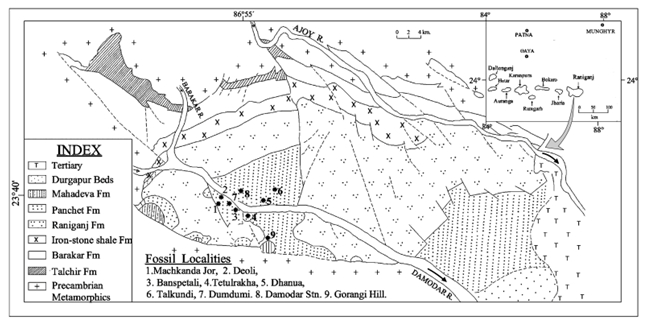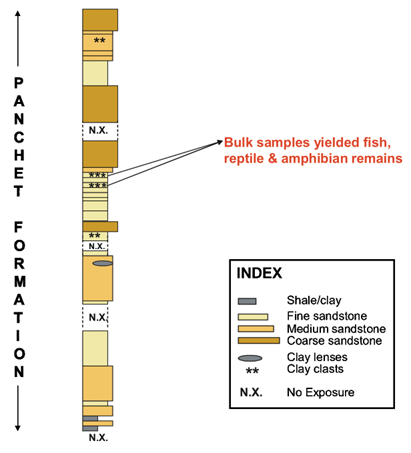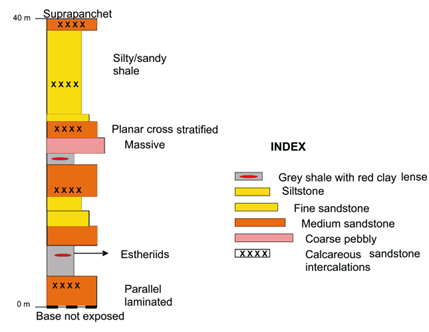Panchet Fm
Type Locality and Naming
Damodar-Koel Valley: Panchet Hill. Named after Panchet hill, the base of which is composed of this formation. [Original Publication: Blanford, W.T. (1861): On the geological structure and relations of the Raniganj coalfield, Bengal. Mem. Geol. Surv. Ind., 3(1), 1-196]
[Figure 1: Geological map of Raniganj Coalfield with an inset of different Damodar valley coalfields (adapted from Tripathi & Satsangi, 1963; Gupta 2009)]
Lithology and Thickness
Sandstone. It consists of alternating beds of coarse-grained feldspathic, micaceous, yellow-brown sandstone, thin bands of khaki-green shales and variegated and red clay beds. Bands of impure limestone and conglomerate also occur occasionally, the later with lateritic nodules.
Lower Panchet Formation comprises mostly thin sandstone beds of khaki green, pale yellow and greenish-grey colors alternate with predominantly red colored argillaceous rocks. The sandstones are primarily arkosic with subordinate quartz arenite and trough cross-stratified. The Lower Panchet Formation is rich in Lystrosaurus fossils (earliest Triassic tetrapod).
Upper Panchet Formation comprises coarse- to medium-grained, yellowish-brown, massive to planar or trough cross-bedded sandstone with subordinate siltstone and argillaceous rocks such as red clay and grey shale. The sandstones yield remains of temnospondyl amphibians and cynodont mammal-like reptiles (Gupta, 2009).
Thickness of the formation is about 600 m in Raniganj Coalfield, about 430 m in Bokaro Coalfield and about 200 m in Auranga Coalfield.
[Figure 2: Lithocolumns of Lower Panchet Formation (A) exposed near Dumdumi village (150 m thick) and B) Upper Panchet Formation exposed near Gorangi Hill area (adapted from Gupta, 2009)]
Relationships and Distribution
Lower contact
Panchet Formation has conformable gradational contact with the underlying Raniganj Fm except at places in East Bokaro Coalfield where it overlies older formations and in Auranga Coalfield, where Panchet Formation lies directly over the Barakar Fm (Raja Rao, 1987).
Upper contact
Panchet Formation is overlain by Mahadeva Fm (= Supra-Panchet Fm; Neither are yet entries in this on-line Lexicon. "Supra-Panchet" is indicated as spanning only the lower Jurassic in a summary stratigraphic column by S.K. Acharyya, 2019, Chapter 2 In his Tectonic Setting and Gondwana BasinArchiecture in the Indian Shield; but with no details). This upper contact is an angular unconformity in Karanpura (Jewett, 1925) and Raniganj coalfield; but in Lugu hill area, Bokaro, the Panchet Formation is conformably overlain by the Mahadeva Fm, though in most places pronounced unconformity is noticed.
Regional extent
Damodar-Koel Valley: Exposures are in Bokaro coalfield, North Karanpura, Auranga, Ramkhola-Tatapani and Talchir
GeoJSON
Fossils
Vertebrate fossils reported are: Fish: Amblypterus sp. (Tripathi, 1969), Actinopterygian indet., Ptychoceradotus sp., Perleidiformes indet., Chondrichthyes indet. (Gupta, 2009); amphibians: Indobenthosuchus (Lydekkerina) panchatensis (Tripathi 1969; Schoch and Milner 2000), Pachygonia incurvata, Gonioglyptus longirostris (Huxley, 1865), Gonioglyptus (Indolyrocephalus) huxleyi (Lydekker 1882; Tripathi 1969), Indobrachyops panchatensis (von Huene and Sahni, 1958), Manubrantlia khaki (Yates and Sengupta, 2002); Reptiles and mammal-like reptiles: Ankistrodon indicus (Huxley, 1865), Lystrosaurus (maccaigi, rajurkari, platyceps) murrayi (Tripathi and Satsangi 1963, Ray 2005), Thrinaxodon bengalensis (Satsangi, 1987), Panchetocynodon damodarensis (Das and Gupta, 2012).
Two distinct Estheriid zones have been marked in the Panchet Formation (Ghosh et al., 1987). The lower Panchet is marked by Cyzicus-Estherilla Biozone and the upper by Palaeolimandia Biozone. Estheriid Fauna comprises, Estheriella sastryi, Cornutesteriella tachi, Cornia panchetella (Tash),Crzicus (Euestheris) minima (Jones), Palacolimnadia sp. Cornia pancetella, Vertexia and Gabonestheria (Ghosh, 1993). Among insects, Coleoptera and Odonneta are present (source Peters, 2009).
Flora commonly comprises Glossopteris conspicua, G. intermedia, G. bosei, G. leptoneura, Schizoneura gondwanensis, Trygyzia speciosa, Pecopteris conina, Cyclopteria pachyrach, Lepidopteris and Podozamites (Bose et al. 1977, 1989; Nandi, 1992). Among palynofossils, miospores, Dictyophyllidites, Punctatisporites, Verrucosporites, Osmundacidites, Lundblasdispora, Densisporites, Playfordiospora, Nevesporites, Lunatisporites, Alisporites, Klausipollenites and Falsisporites are present that correspond to Palynoevent-6 (Lower Triassic: Induan) of Tiwari (1996). This assemblage has been classified by Tiwari and Tripathi (1992) as Klausipollenitess schaubergeri Zone. The megaspores consist of Bankisisporites (dominant), Beharisporites, Verrutriletes, Talchirella, Pantiella, Maiturisporites and Umiaspora (Pal et al. 1997).
Age
Depositional setting
The Panchet Formation is a coarsening-upward sequence and has been divided into three parts (Robinson, 1970). According to Robinson (1970), the Lower part of Panchet Formation is dominated by fine-grained interchannel deposits whereas the Middle part has both channel and interchannel facies. The sediments in the upper part were deposited rapidly by large, high-energy river channel. The channel sand bodies in the Upper part of the formation contain pebble beds with small quartz pebbles, feldspar chips and mud clasts. Bandyopadhyay (1999) interpreted Panchet Formation to have been laid in a fluviatile - lacustrine environment with overall paleocurrent trend from NW to NE (Veevers and Tewari, 1995).
Additional Information
References
Bandyopadhyay (1999; Blanford, W.T. (1861); Bose et al. 1977, 1989 ; Das and Gupta, 2012; Ghosh et al., 1987; Ghosh, 1993; Gupta, 2009; Huxley, 1865; Jewett, 1925; Lydekker 1882; Nandi, 1992; Pal et al. 1997; Raja Rao, 1987; Ray 2005; Robinson, 1970; Satsangi, 1987; Schoch and Milner 2000; Tiwari 1996; Tiwari and Tripathi (1992; Tripathi, 1969; Tripathi and Satsangi 1963, ; Veevers and Tewari, 1995; von Huene and Sahni, 1958; Yates and Sengupta, 2002;


